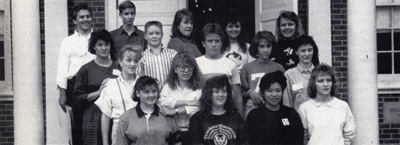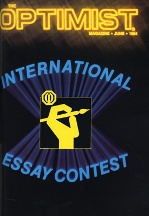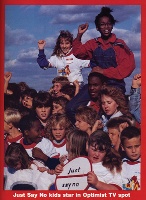The 1980s
|
A special Optimist program for high school students, the Essay Contest, was launched in 1983. Students are asked to write an essay on an assigned topic as they compete for top honors at the Club level. Winners are then entered in District competition and from the District winners, an International-level winner is selected. The contest continues to be one of the most popular service projects conducted by Optimist Clubs today. In 1985, Optimist International endorsed the national Just Say No program and introduced an anti-drug program for use by Clubs. Optimists recognized that drug abuse was the most serious problem facing young people at the time. Because peer pressure was considered the major reason why young people experiment with drugs, the major thrust of Just Say No was to counter this peer pressure. Although Optimists were just one of many supporters of Just Say No, they were perhaps the most active. Less than two years after launching its program, Optimist International had already reached nearly 1.5 million children in nearly 10,000 schools. Optimist Youth Clubs took a major step forward the weekend of September 9-11, 1988. Delegates representing Youth Clubs from throughout the organization held their first international convention and formed an international organization, Junior Optimist Octagon International, to become known more familiarly as JOOI. Elected as their first international president was Adriana Johnson of San Antonio, Texas. The 1980s was a decade of tremendous growth. In the first 50 years of the organization’s existence, Optimist Club membership grew steadily until hitting the 100,000 mark in 1969. However, just over a decade later, membership topped the 130,000 plateau in 1980. And by the end of the decade, Optimist International reached the zenith of its membership rise with over 175,000 members. |
| The continued growth of Optimist International was apparent not only in the number of members and Clubs, but in the corresponding number of Districts. As Districts grew larger it became more difficult for the District leaders to give as much of their time as they would have liked to each Club. Deeming it necessary to sub-divide existing Districts, the International Board of Directors, between 1981 and 1986, expanded from 38 to 50 the number of Districts. The province of Ontario was divided into four Districts and the state of North Carolina into three. Missouri, Indiana and Florida were each divided into two Districts, and two new Districts were formed from the former Pacific Southwest District. |
The most significant geographic change from the 1960s through the 1980s was the growth in Quebec. In 1966, there were only 36 Optimist Clubs in that Canadian province. That number swelled to over 350 by 1980, when the organization had its first French-Canadian International President, Lionel Grenier of Terrebonne, Quebec. |
 The first youth convention took place in 1988 and was the beginning of Junior Optimist Octagon International. |
| Growth in Quebec was staggering during this period. In 1977-78, 52 new Clubs were built. Two years later, 60 new Clubs were formed in Quebec, a record for any District that still stands. By October of 1988 when Fernand Rondeau of Montreal assumed the presidency, Optimist International had over 30,000 members in over 700 Clubs in Quebec, which at the time represented nearly 20% of the entire organization. |

